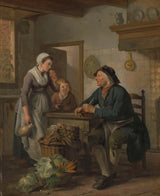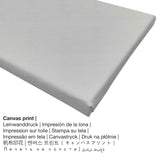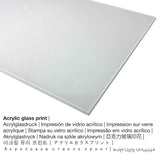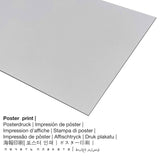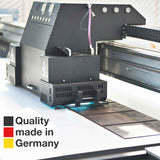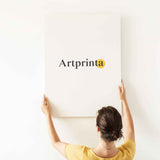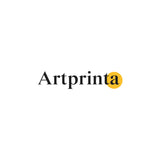Adriaan de Lelie, 1796 - Nleta ụtụtụ - mbipụta nka mara mma
Ụtụ gụnyere. Mbupu gbakọrọ na ndenye ọpụpụ.
Nhọrọ akụrụngwa ngwaahịa gị
Maka mbipụta nka ọ bụla anyị na-enye nha na ihe dị iche iche. Nha na ihe ndị a bụ nhọrọ anyị na-enye gị maka nkeonwe:
- Mbipụta akwụkwọ mmado (ihe kwaaji): The Artprinta poster is a UV printed sheet of canvas paper with a granular surface structure. It is optimally designed for framing the art print with a special frame. Please bear in mind, that depending on the absolute size of the poster print we add a white margin of approximately 2-6 cm around the print, which facilitates the framing with your custom frame.
- Mbipụta iko acrylic (nke nwere ezigbo mkpuchi iko): The acrylic glass print, often denoted as a UV print on plexiglass, makes the original work of art into great décor and offers a great alternative to canvas and dibond prints. The artwork is being made with modern UV printing machines. This creates the effect of rich, stunning color tones. The great advantage of a plexiglass print is that contrasts and also minor painting details will be exposed with the help of the precise gradation of the picture. Our acrylic glass protects your selected art replica against light and heat for many decades.
- Aluminom dibond (ọkpụkpụ ọla): This is a metal print manufactured on aluminium dibond material with an outstanding depth - for a modern look and a non-reflective surface structure.
- Mbipụta kanvas: A canvas direct print is a printed canvas stretched on a wood stretcher. A printed canvas of this artpiece will give you the unique opportunity of turning your custom fine art print into a large collection piece as you know from galleries. Canvas Prints have the advantage of being relatively low in weight. This means, it is easy to hang up the Canvas print without any wall-mounts. Therefore, a canvas print is suitable for all kinds of walls.
Disclaimer: We strive in order to describe our products with as many details as possible and to display them visually on the respective product detail pages. At the same time, the colors of the print materials and the imprint might differ slightly from the representation on your monitor. Depending on your settings of your screen and the quality of the surface, color pigments might not be printed one hundret percent realistically. Given that all the fine art prints are printed and processed by hand, there might as well be slight discrepancies in the motif's size and exact position.
Ozi nkowa mgbakwunye na mbụ artwork by Rijksmuseum (© Nwebiisinka - site Rijksmuseum - Rijksmuseum)
De Lelie painted this typically Dutch kitchen scene in the tradition of 17th-century genre painting. It probably served as the pendant to the Woman Baking Pancakes in this gallery. Just as in the Golden Age, this painter was interested in rendering the various details with the utmost realism: the basket of vegetables, the earthenware jug, the pewter on the mantelpiece, and the brassware hanging on the white tiled wall.
Nchịkọta ngwaahịa
Ihe karịrị 220 afọ masterpiece a na-akpọ Morning Visit e sere ya rococo onye na-ese ihe Adriaan de Lelie in 1796. E wezụga nke ahụ, ihe osise ahụ bụ akụkụ nke Rijksmuseum's digital collection, nke bụ ihe ngosi nka kacha ukwuu maka nka na akụkọ ihe mere eme Dutch site na Middle Ages ruo ugbu a. Nke a nka ochie A na-enye ọrụ nka, nke bụ nke ọha na eze site n'ikike nke Rijksmuseum.Furthermore, the artpiece has the creditline: . On top of that, alignment of the digital reproduction is in portrait format with a side ratio of 1 : 1.2, meaning that the length is 20% shorter than the width. The painter Adriaan de Lelie was a European artist, whose style can primarily be attributed to Rococo. The European painter was born in the year 1755 ma nwụọ mgbe ọ dị afọ 65 n'afọ 1820.
Data ndabere gbasara nka
| Aha nka nka: | "Morning Visit" |
| Nhazi nke ọrụ nka: | sere |
| Okwu mkpokọta: | nka ochie |
| Century: | 18th narị afọ |
| Year: | 1796 |
| Afọ nka: | ihe dị ka afọ 220 |
| Ụlọ ihe ngosi nka: | Rijksmuseum |
| Ebe ebe ngosi nka: | Amsterdam, Netherlands |
| Weebụsaịtị nke ihe ngosi nka: | Rijksmuseum |
| Ụdị ikike nka: | ngalaba ọha |
| Site n'aka: | Rijksmuseum |
Ozi ndabere ihe
| Nkewa ngwaahịa: | ọmarịcha nka |
| Usoro mmeghari: | dijitalụ mmeputakwa |
| Produzọ mmepụta: | Mbipụta UV ozugbo (mbipụta dijitalụ) |
| Mmalite nke ngwaahịa a: | arụpụtara na Germany |
| Ụdị ngwaahịa: | mmepụta ihe na-achọ |
| Ngwaahịa were: | ihe ndozi mgbidi, ihe ndozi ụlọ |
| Nhazi nke ihe nka: | nhazi ihe osise |
| Njikwa oyiyi: | (ogologo: obosara) 1: 1.2 |
| Nkọwa: | ogologo bụ 20% mkpụmkpụ karịa obosara |
| Ụdị ihe dị iche iche dị: | ígwè obibi akwụkwọ (aluminium dibond), ebipụta canvas, mbipụta akwụkwọ mmado (akwụkwọ kwaaji), mbipụta iko acrylic (nwere ezigbo mkpuchi iko) |
| Mbipụta kanvas (akwa akwa n'elu etiti ihe ndọtị) ụdị nha dị iche iche: | 50x60cm - 20x24", 100x120cm - 39x47" |
| Acrylic glass print (nwere ezigbo mkpuchi iko) nhọrọ: | 50x60cm - 20x24", 100x120cm - 39x47" |
| Ụdị akwụkwọ mmado (akwụkwọ kwaaji) dị iche iche: | 50x60cm - 20x24", 100x120cm - 39x47" |
| Mpempe akwụkwọ Dibony (ihe alumnium) nha dị iche iche: | 50x60cm - 20x24", 100x120cm - 39x47" |
| ụba: | mbipụta nka na-enweghị isi |
Tebụl metadata omenkà
| Aha onye nka: | Adriaan de Lelie |
| Aha utu aha: | A de Lely, Lelie, de Lelij, A. de Lely, adrieande lelie, de Lely, Lely, de Lelie, de Lelie d'Amsterdam, A de Lelie, De Lelie of Amsterdam, Adriaan de Lelie, Lelie Adriaan de, De Liley |
| okike onye nka: | nwoke |
| Obodo onye nka: | Dutch |
| Ọrụ: | onye na-ese ihe |
| Mba onye si: | mba netherland |
| Otu nka: | nna ukwu ochie |
| Ụdị nka: | Rococo |
| Ndụ: | 65 afọ |
| Afọ amụrụ: | 1755 |
| Afọ nwụrụ: | 1820 |
© Nwebiisinka nke - www.artprinta.com (Artprinta)

